
Qatar and the 250 Billion Dollar Party
“Are you the next Dubai?” “No, we are Qatar” was the firm response from our tour guide.
A summary of our trip that’s perfect for a tweet or tagline for a tourism campaign. For 5 days our small group of journalists were taken on a whirlwind tour of the tiny peninsula with a population of only 2.7 million. A nation that was the centre of the pearl diving trade until the Japanese revolutionised the industry in the 1930s, Qatar is now having its ‘Beijing 2008’ moment, its ‘coming-out’ party of sorts. Over the last 20 years, the Kingdom has invested over $250 Billion in infrastructure, energy, tourism and a huge PR campaign culminating in this winter’s FIFA World Cup. That’s plenty of cash to splash, as I was about to find out.
Having almost missed my 6.5-hour Qatar Airways flight due to taking the wrong covid test, we finally made it to Doha where we were whisked away through immigration, bundled into a Taxi, and zipped over to the Souq Al Wakra Hotel Qatar by Tivoli, our accommodation for the next 5 nights. Greeted on arrival with trays of alcohol-free cocktails that became a staple of our trip, this 5-star hotel is the same one hosting the England football team this month as they aimed, yet failed to end 56 years of hurt. An expansive collection of low-rise buildings and hotel rooms, like a Souq but without the market stalls. A maze of alleyways and courtyards complete with Bedouin-style tents for where no doubt team tactics and match debriefs are happening each day.
The place is like a high-class village secured with 8-foot walls and staff driving around in golf buggies. This being the England team hotel meant they had to expect the odd demand from Gareth and FA, to seal the deal Souq Al Wakra Hotel agreed to transform a courtyard fountain into an outdoor pool.

Souq Al Wakra Hotel Qatar by Tivoli – Courtyard Fountain

Souq Al Wakra Hotel Qatar by Tivoli – Majlis

Souq Al Wakra Hotel Qatar by Tivoli – Junior Suite
Speeding around in our minibus on the smooth, new motorways we passed diggers, cranes, building sites and shiny, skyscrapers adorned with 50-foot-high billboards of footballers. It’s like visiting a multi-millionaire’s mansion with 6 months to go in completing the west wing extension.
But mini-buses reminded me too much of my mid 90’s school trips, so I wanted to upgrade to a Jet Ski and the Grand Hyatt Doha gave me one. Skipping along the Doha coastline you can take in the panoramic skyline, including the 5-star luxury Fairmont Doha in the Katara Towers. A twin-towered hotel, designed in the shape of traditional scimitar swords, the national emblem of Qatar. Straight out of Star Wars or Blade Runner, this is one of the multiple postcard buildings, built to be the iconic Doha image once the World Cup has packed up and moved on.

Jet Skis and Doha Skyline

Fairmont Doha, Katara Towers
No trip to this part of the world would be complete without a desert safari.
An hour’s drive away from central Doha and after a brief camel ride, we swapped our transport for a 4WD taking us on a roller-coaster sand bashing session and a lesson of some sandboarding thrown in. With the sun setting over the dunes, this was the classic image I had of this part of the world before my departure and fully met my expectations; a definite highlight.

Sandboarding

Inland Sea

Keeping with the desert theme, we spent the evening at Sealine Desert Camp at Khor Al Udaid, or the Inland Sea. A small resort inspired by a Bedouin camp where we were treated to a Zarb, a traditional goat dish, slowly cooked underground in earth ovens for 7 hours. Absolutely delicious; amongst all the modern developments and impressive architecture, it’s these moments of tradition that stand out for me.

Sealine Desert Camp, Khor Al Udaid (Inland Sea)

Revealing the Zarb, after cooking 7 hours under the sand

Dinner is served
The FIFA world cup may be the most high-profile sports event Qatar has hosted, but it’s certainly not the first. Over the 20 years, the small nation has been the venue for Asian Games (2006), World Handball Championships (2015), World Athletic Championships (2019) and World Beach Games (2019). Hosting two stages for the GKA Kite World Tour (Kite Surfing) in 2023 and 2024 will be the Fuwairit Kite Beach Resort. A 90-minute drive from Doha on the northern tip of the peninsula is the 40-room, beach-facing accommodation that takes full advantage of its shallow lagoon and consistent winds to jump on the ‘surf tourism’ bandwagon. Four years and $1,000,000 in the making, the resort includes a pool, yoga pavilion, paddle courts, an outdoor cinema, and a state-of-the-art gym. This is pure escapism with its white sands, and brightly coloured rooms scattered with modern art designs. If your partner is over football already, send them here, just not over the next 6 weeks as the German football team booked up the entire place and shipped off their wags.

Exploring the Lagoon at Fuwairit Kite Beach Resort

Fully booked by German WAGS




We had been told how the Qatari government is well aware of the importance of legacy after this world cup. I can think of the Athens (2004) or Rio Olympics (2016) as examples where the crowds failed to stay after the cameras and sport had left. Qatar says they have a legacy plan up to 2030 to keep attracting investment and tourism. The Qatari government would have looked towards Bilbao’s Guggenheim or Dundee’s V&A as examples of how museums or galleries can put a city on the map, so not to be outdone Doha has recently opened two of its own.
The National Museum of Qatar rises from the sands of Doha like a collection of spinning discs spliced together. Opened in 2019 at a cost of $434 million, the architect Jean Nouvel ( the man behind Abu Dhabi’s Louvre) was inspired by the desert rose crystal, a new symbol of Qatar. Over 11 galleries, it covers the history of being a country of pearl divers and Bedouin tribes to becoming one of the world’s richest nations via the discovery of oil and natural gas reserves. For a country with a population a third the size of London and an area smaller than Wales, I was surprised how much was packed in; I could have stayed another couple of hours, at least, learning more about this desert nation’s remarkable economic journey.

The National Museum of Qatar



Walking across a foot bridge towards Doha bay’s Museum of Islamic Art is another building that is as dramatic as the work inside. Built offshore on reclaimed land is a temple dedicated to Islamic work covering 1,300 years over five floors. With a design heavily influenced by a traditional mosque, the gallery offers panoramic views of the Doha West Bay skyline area from all five floors of the atrium. As a graphic designer and typographer, this was a treasure trove of inspiration. I spent most of my time looking over the huge collection of antique Qurans, some over 1,500 years old, some covered in gold leaf, delicately written on ancient leather using various types of dried reed.

Museum of Islamic Art

Antique Qurans



Due to the heat, nights are when the locals head out and the market comes alive, as we saw on our visit to Souq Waqif, the oldest market of Qatar recently developed but keeping to its traditional architectural style. I’ve been to a few markets of this type across the Middle East and Asia and what stands out with Souq Waqif is how clean, civilised and orderly everything is. Families, young and old, couples of all ages, and tourists all fill up the restaurants and cafes; parrots for sale, live chickens, the smell of spices and bread baking in clay ovens.

Souq Waqif




The biggest discovery of the night though was learning about the national bird of Qatar, the falcon. Falcons here are seen as a status symbol. Instead of that luxurious car or a Rolex watch, you would head to the Souq Waqif and spend sometimes hundreds of thousands of dollars for a bird, which traditionally would be used for hunting. Entering one of the back street falcon shops, we saw 20 or so birds, tied to their perches, eyes covered with tiny helmets waiting for a buyer. This is big business; so much so that there is a fully dedicated, 4-floor falcon hospital around the corner to fix that broken limp or strap on a replacement wing.

Falcon shopping




Souq Waqif Falcon Hospital 
To fully take in the scale of what development of the city, there is no better way than a trip around Doha Harbour. For our final afternoon, we were taken for a BBQ lunch on a Dhow boat cruise. Looking back towards the coast, you see the full extent of the rapidly built modern skyline to our right, the Museum of Islamic Art, a new entertainment area full of restaurants, apartment complexes, a port that will be filled with cruise liners to provide the added World Cup accommodation, even a Doha branch of a Box Park. Amazingly there’s even a Winter Wonderland; apparently, they were so impressed with the annual winter attraction in London’s Hyde Park that they built their own, in 30°C heat, in the desert. Only in Qatar, I guess.

Dhow boat cruise

Doha Skyline from our Dhow boat


Our Qatar Crew
And so on second thought, maybe that makes a better tagline. As only in Qatar can cities spring up over a decade, can you build winter attractions in the scorching heat and can a Brit enjoy a night out without a drop of alcohol. This trip raised my curiosity and that is why I would go back in a couple of years’ time. They have set themselves high ambitions, and I can’t wait to see the final result.
For further information and to plan your visit to Qatar, head to www.visitqatar.com.
Flights – Qatar Airways flies seven times a day from London’s Heathrow and Gatwick airports direct to Doha’s Hamad International Airport, and onwards to more than 140 destinations globally. For further information and to book a flight, visit www.qatarairways.com.
Hotel – Souq Al Wakra Hotel Qatar by Tivoli. Doubles from £76 per night, visit https://www.tivolihotels.com/en/souq-al-wakra-tivoli




